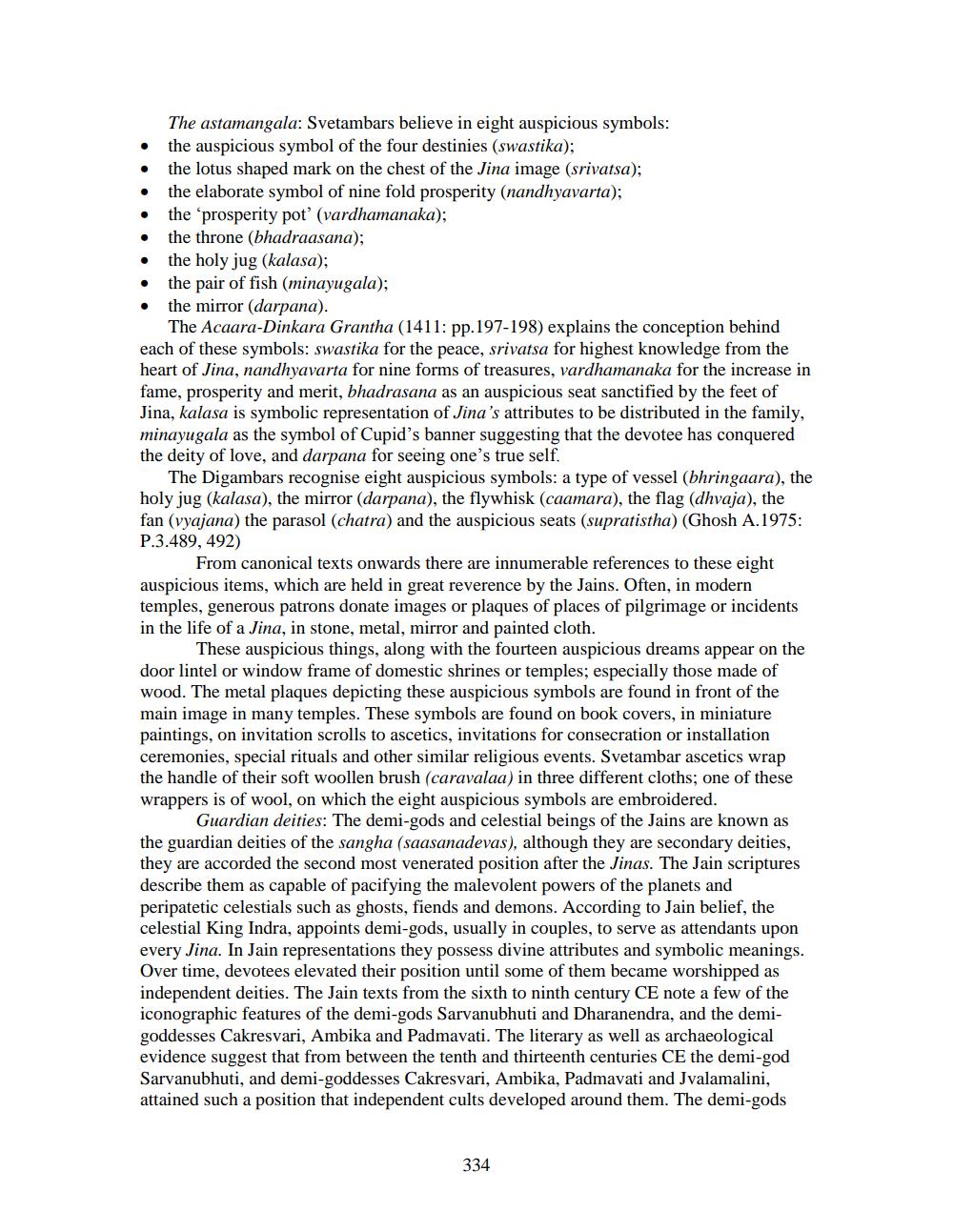________________
The astamangala: Svetambars believe in eight auspicious symbols: the auspicious symbol of the four destinies (swastika); the lotus shaped mark on the chest of the Jina image (srivatsa); the elaborate symbol of nine fold prosperity (nandhyavarta);
the prosperity pot' (vardhamanaka); • the throne (bhadraasana);
the holy jug (kalasa);
the pair of fish (minayugala); • the mirror (darpana).
The Acaara-Dinkara Grantha (1411: pp.197-198) explains the conception behind each of these symbols: swastika for the peace, srivatsa for highest knowledge from the heart of Jina, nandhyavarta for nine forms of treasures, vardhamanaka for the increase in fame, prosperity and merit, bhadrasana as an auspicious seat sanctified by the feet of Jina, kalasa is symbolic representation of Jina's attributes to be distributed in the family, minayugala as the symbol of Cupid's banner suggesting that the devotee has conquered the deity of love, and darpana for seeing one's true self.
The Digambars recognise eight auspicious symbols: a type of vessel (bhringaara), the holy jug (kalasa), the mirror (darpana), the flywhisk (caamara), the flag (dhvaja), the fan (vyajana) the parasol (chatra) and the auspicious seats (supratistha) (Ghosh A.1975: P.3.489, 492)
From canonical texts onwards there are innumerable references to these eight auspicious items, which are held in great reverence by the Jains. Often, in modern temples, generous patrons donate images or plaques of places of pilgrimage or incidents in the life of a Jina, in stone, metal, mirror and painted cloth.
These auspicious things, along with the fourteen auspicious dreams appear on the door lintel or window frame of domestic shrines or temples; especially those made of wood. The metal plaques depicting these auspicious symbols are found in front of the main image in many temples. These symbols are found on book covers, in miniature paintings, on invitation scrolls to ascetics, invitations for consecration or installation ceremonies, special rituals and other similar religious events. Svetambar ascetics wrap the handle of their soft woollen brush (caravalaa) in three different cloths; one of these wrappers is of wool, on which the eight auspicious symbols are embroidered.
Guardian deities: The demi-gods and celestial beings of the Jains are known as the guardian deities of the sangha (saasanadevas), although they are secondary deities, they are accorded the second most venerated position after the Jinas. The Jain scriptures describe them as capable of pacifying the malevolent powers of the planets and peripatetic celestials such as ghosts, fiends and demons. According to Jain belief, the celestial King Indra, appoints demi-gods, usually in couples, to serve as attendants upon every Jina. In Jain representations they possess divine attributes and symbolic meanings. Over time, devotees elevated their position until some of them became worshipped as independent deities. The Jain texts from the sixth to ninth century CE note a few of the iconographic features of the demi-gods Sarvanubhuti and Dharanendra, and the demigoddesses Cakresvari, Ambika and Padmavati. The literary as well as archaeological evidence suggest that from between the tenth and thirteenth centuries CE the demi-god Sarvanubhuti, and demi-goddesses Cakresvari, Ambika, Padmavati and Jvalamalini, attained such a position that independent cults developed around them. The demi-gods
334




